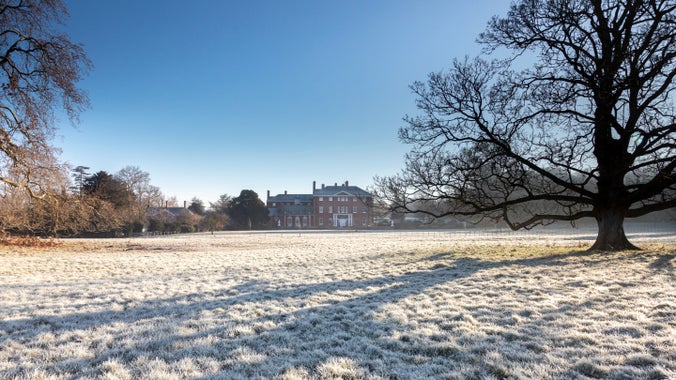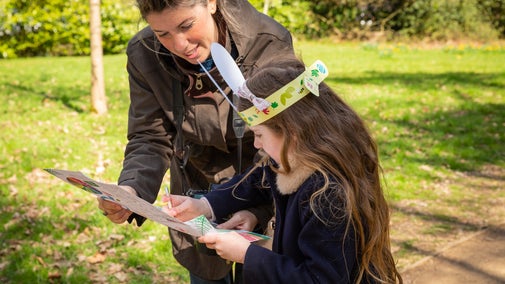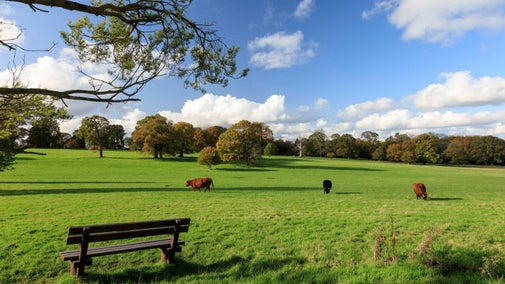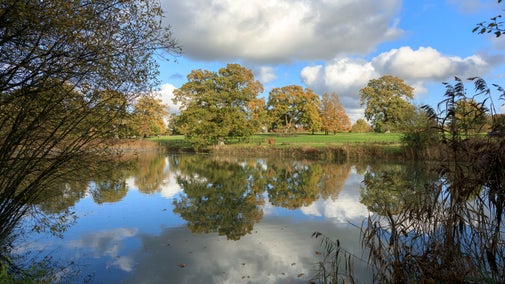
Become a member
Join today and help protect nature, beauty and history – for everyone, for ever. Enjoy access to more than 500 places with National Trust membership.
Stretches of sweeping parkland sheltering a classic country house
East Clandon, Guildford, Surrey, GU4 7RT

| Asset | Opening time |
|---|---|
| House | Closed |
| Café | 10:00 - 15:30 |
| Meadow & parterre | Closed |
| Park walks | 10:00 - 16:00 |
| Engine Room bookshop | 10:00 - 15:30 |
The gates to the visitor car park will be opened shortly before 10am. Last entry to the estate is 30minutes before our listed closing time. The car park is locked shortly after our listed closing time; please ensure you have returned to your vehicle in time. The west lawn in front of the house and the wider parkland, including walks, are open 363 days a year. House opening hours are more limited because Hatchlands is a family home.
| Ticket type | With Gift Aid | Without Gift Aid |
|---|---|---|
| Adult (18+) | £15.40 | £14.00 |
| Child (5-17) under 5s free | £7.70 | £7.00 |
| Family (2 Adults and up to 3 children) | £38.50 | £35.00 |
| 1 adult, and up to 3 children | £23.10 | £21.00 |
| Group (Adult 18+) | £13.30 | |
| Group (Child 5-17) | £6.65 |
Audio guides of the house available for an extra charge.
You can find the Engine room bookshop, our second-hand bookshop in the cobbled courtyard.
The Kitchen Café serves barista-style hot and cold drinks, hot and cold meals, ice creams, children's lunches, pastries and cakes and bakes to eat in or take away. If you bring your own cup, we will give you 25p off as a thank you. We have high chairs and accessible crockery and cutlery.
Café - more informationThere is plenty of parking, with the main car park being on hard standing. The overflow car park is open during busy periods. There is no charge for car parking.
Assistance dogs only in the house, the formal gardens and the children's natural adventure area. Well-behaved dogs under close control are welcome in designated parkland areas. Please ensure your dog is on a lead around livestock. Dogs on leads are welcome in the both cafés.
Six 11kW electric vehicle charging points are available in the main car park. Chargers can be accessed using mobile app, RFID card, or a contactless payment device. Visit our EV charging provider RAW Charging’s website (rawcharging.com/drivers) to download the app in advance of your visit. Chargers are only available to visitors during opening hours.
The toilets can be found in the cobbled courtyard.
Blue Badge parking. All-terrain Tramper available to book. Wheelchairs available. Accessible toilet. Partly accessible parkland with some uneven terrain. Ramp to house.
There is one accessible toilet available in our cobbled courtyard.
We have eight accessible spaces in our visitor car park, located near visitor reception.
Induction loop is available in the Kitchen Café and visitor reception.
The Kitchen Café has level access.
There are hard standing routes, please ask at visitor reception.
Tramper personal powered mobility vehicles, MT Push all Terrain wheelchair, MT epush and manual wheelchairs are available to borrow for no charge. Please book ahead or ask at visitor reception.
There is a ramp to the entrance of the house.
Seating available in the cobbled courtyard. There are benches in the park and garden.
The park can be uneven underfoot. There are hard surfaced routes available.
There is a staff driven golf buggy available from the car park to the house/cobbled courtyard.
There are wheelchairs available at visitor reception and the house.
From family trails and activities to guided walks and summer outdoor theatre, we host a variety of events and happenings throughout he year. Take a look at what's coming up.

With plenty of open spaces to explore, a natural play area in Great Wix Wood, resident donkeys and the Snowdog Christmas trail, there's lots to discover at Hatchlands Park for families. Find out more about planning your family visit to Hatchlands this winter.

View or download a map of Hatchlands to help plan your visit. See where to find the house, second-hand bookshop, café and toilets and which direction to take when setting off for a parkland walk.

How far away is the natural play area? Where can I find the resident donkeys? Download our map just for families here or pick one up from visitor reception on your next visit.

Hatchlands is a two pawprint rated place. Discover two dog-friendly walking routes and some helpful hints for a happy and safe experience in the parkland and woodland.

Discover everything you need to know about bringing your group to Hatchlands Park.

Georgian country house with Robert Adam ceilings and fireplaces. Collection of keyboard instruments linked to famous composers.
Sweeping lawns with a small fountain, a parterre garden and meadow.
Over 400 acres of parkland partly landscaped by Humphry Repton, with ancient woodlands, pasture meadows and a pond.
Exterior viewing of the Georgian Ice House in the garden.
Found in the garden, an 18th-century classical stone folly, inscribed with a tribute to a beloved mother.
A natural play area set in woodlands with balance beams, stepping stones, willow domes, bug burrow and tree house.
Coach House Café serves takeaway drinks, cakes, snacks and lunches. The Kitchen Café has eat in or takeaway options.
Set in the cobbled courtyard, the Engine Room bookshop offers a wide variety of fiction and non-fiction pre-loved books.
Stuck for something to do outdoors with the family? Look no further, with our natural adventure area, lots of space to around in and resident donkeys to meet, Hatchlands Park is the perfect spot to get some fresh air.

Discover the best bits of the parkland at Hatchlands. Spanning over 400 acres and just 45 minutes outside Greater London you’ll find a fun outdoor adventure, whatever the season.

This Georgian country house contains the remarkable Cobbe collection of art and keyboards and pianos, owned or played by famous composers. Please note: the house is now closed for winter conservation work. The six ground floor rooms are open 1 March to 30 October, daily except Saturdays.

The park walks at Hatchlands run around and through a working farm with sheep and cattle grazing from spring until autumn. This conservation grazing allows grassland species to flower and provides food sources for endangered butterflies. Livestock are often kept behind electrified fences. While the voltage is very low, the fences are clearly signed and are set back from paths, they can still provide a shock, so please take care. Always avoid getting between animals and their young, keep dogs on a short lead and, if a cow approaches, let your dog off the lead.

This winter treat yourself to a warming lunch, a festive drink or tasty bake from the courtyard cafés. Pop into the Engine Room bookshop and browse the pre-loved books for your next good read, with all donations going towards vital conservation projects across the Hatchlands Park estate.

From a brisk winter walk around the whole of the parkland, to a stroll along the all-weather paths to the natural adventure area in Great Wix Wood or a meander through the garden to the courtyard, there's plenty to explore at Hatchlands Park this winter.
This circular walk follows the edge of the park through woodland and open parkland with distant views of the house and the wider Surrey countryside.

This circular walk cuts across the centre of the estate through woodland and open parkland, passing our children's adventure area and the cobbled courtyard. Follow the purple arrows on our waymarker posts.

Download our map for an overview of Hatchlands Park. Follow one of our trails, or find a path to suit you. You can also pick up a map from reception.
Sorry, there are no upcoming events at this place
Hatchlands Park was built in the 1750s for naval hero Admiral Edward Boscawen and his wife Fanny, since then it has housed wealthy families, a finishing school for girls and even a printing press. Today you can visit the parkland or stop for coffee in the Kitchen Café all year round. You can also see inside our house on six afternoons a week, between March and October.
Take the time to wander through our 400 acres of rolling parkland and woodland, one of the largest country estates in the area and full of year round seasonal colour. You can follow waymarked walks, enjoy the tranquillity of our garden, discover areas of the park partly landscaped by Humphry Repton or bring the family to experience our natural adventure area for children.
Our mansion is now a family home, containing tenant Alec Cobbe’s collection of paintings and fine furniture. Also on display is the Cobbe Collection, Europe’s largest collection of keyboard instruments associated with famous composers including JC Bach, Chopin and Elgar. An early interior design commission for architect Robert Adam, his work can be seen in ceilings and fireplaces throughout the house.
Situated on the edge of the beautiful Surrey Hills and surrounded by charming villages, this peaceful location is just 45 minutes from central London.
Discover more about the 250-year history of Hatchlands Park, the families that made it their own and the influences of famous architects and designers of their day.

Find out more about the families that have lived at Hatchlands and made it their home. Discover why the house was rented out and how it would eventually be gifted to the National Trust in 1945.

This incredible collection of over 40 keyboard instruments at Hatchlands Park is one of the largest of its kind in the world. Discover a few of the collection highlights.

Find out how we’re helping nature to thrive across the estate by providing new homes for the hazel dormouse and kingfishers. Our work monitoring the resident butterfly population contributes towards a national mission to assess the species.

Find out how you can volunteer and help all visitors to enjoy this special place and make new friends at the same time.


Join today and help protect nature, beauty and history – for everyone, for ever. Enjoy access to more than 500 places with National Trust membership.
By sharing your email address you’re agreeing to receive marketing emails from the National Trust and confirm you’re 18 years old or over. Please see our for more information on how we look after your personal data.